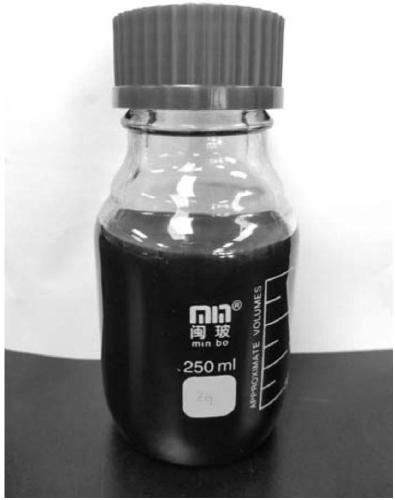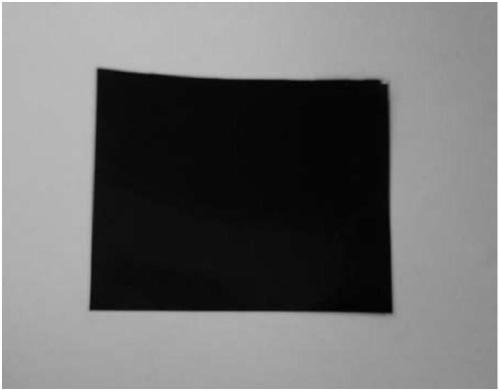Graphene-based thermal interface material and preparation method thereof
A thermal interface material, graphene-based technology, applied in the field of graphene, can solve problems such as high graphene content, many graphene defects, environmental pollution, etc., achieve high concentration and quality, simple process, and wide application range
- Summary
- Abstract
- Description
- Claims
- Application Information
AI Technical Summary
Problems solved by technology
Method used
Image
Examples
Embodiment 1
[0033] A preparation method of graphene-based thermal interface material, comprising the steps of:
[0034] S1. Add 1 part by weight of polyvinylpyrrolidone to 96.5 parts by weight of nitrogen-methylpyrrolidone, stir and dissolve at room temperature, and then add 2 parts by weight of sodium hydroxide.
[0035] S2. Transfer the above solution to a 5L grinding jar of a grinder, and add 0.5 parts of natural flake graphite and 50 parts by weight of zirconia balls.
[0036] S3. Turn on the grinder, set the speed of the grinder to 200 rpm, and grind for 24 hours.
[0037] S4, collect grinding liquid, use 100 mesh copper screens to remove zirconia balls, obtain the graphene dispersion liquid that mass fraction is 0.5%, such as figure 1 shown.
[0038] S5. Take the above 100 parts by weight of the graphene dispersion, add 9.5 parts by weight of epoxy bisphenol A resin, and stir evenly to obtain the first composite.
[0039] S6. Add methyl hexahydrophthalic anhydride to the uniforml...
Embodiment 2
[0042] A preparation method of graphene-based thermal interface material, comprising the steps of:
[0043] S1. Add 2 parts by weight of hexadecylbenzenesulfonic acid to 93 parts by weight of dimethylformamide, stir and dissolve at room temperature, and then add 2 parts by weight of potassium hydroxide.
[0044] S2. Transfer the above solution to a 50L grinding jar of a grinder, and add 3 parts of natural flake graphite and 100 parts by weight of zirconia balls.
[0045] S3. Turn on the grinder, set the rotation speed of the grinder to 500 rpm, and grind for 48 hours.
[0046] S4. Collect the grinding liquid, use a 100-mesh copper screen to remove the zirconia balls, and obtain a graphene dispersion with a mass fraction of 3%.
[0047] S5. Take the above 100 parts by weight of the graphene dispersion, add 27 parts by weight of epoxy bisphenol A resin, and stir evenly to obtain the first composite.
[0048] S6. Add m-phenylenediamine to the uniformly stirred mixture (the firs...
Embodiment 3
[0051] A preparation method of graphene-based thermal interface material, comprising the steps of:
[0052] S1. Add 2 parts by weight of carboxymethyl cellulose to 91 parts by weight of ethanol, stir and dissolve at room temperature, and then add 2 parts by weight of potassium hydroxide.
[0053] S2. Transfer the above solution to a 100L grinding jar of a grinder, and add 5 parts of natural flake graphite and 100 parts by weight of zirconia balls.
[0054]S3. Turn on the grinder, set the speed of the grinder to 1000 rpm, and grind for 96 hours.
[0055] S4. Collect the grinding liquid, and use a 100-mesh copper mesh sieve to remove the zirconia balls to obtain a graphene dispersion with a mass fraction of 5%.
[0056] S5. Take the above 100 parts by weight of the graphene dispersion, add 45 parts by weight of epoxy bisphenol F resin, and stir evenly to obtain the first composite.
[0057] S6. Add ethylenediamine to the uniformly stirred mixture (the first compound), and cont...
PUM
| Property | Measurement | Unit |
|---|---|---|
| thermal conductance | aaaaa | aaaaa |
Abstract
Description
Claims
Application Information
 Login to View More
Login to View More - R&D
- Intellectual Property
- Life Sciences
- Materials
- Tech Scout
- Unparalleled Data Quality
- Higher Quality Content
- 60% Fewer Hallucinations
Browse by: Latest US Patents, China's latest patents, Technical Efficacy Thesaurus, Application Domain, Technology Topic, Popular Technical Reports.
© 2025 PatSnap. All rights reserved.Legal|Privacy policy|Modern Slavery Act Transparency Statement|Sitemap|About US| Contact US: help@patsnap.com



